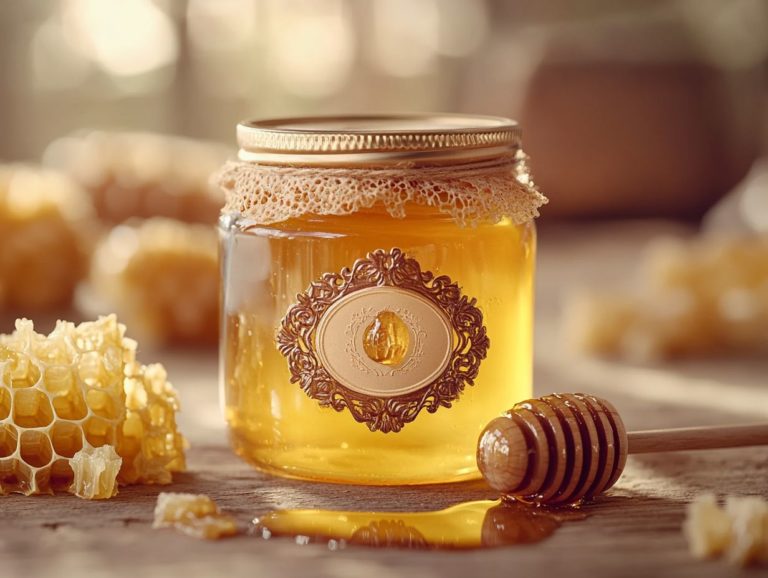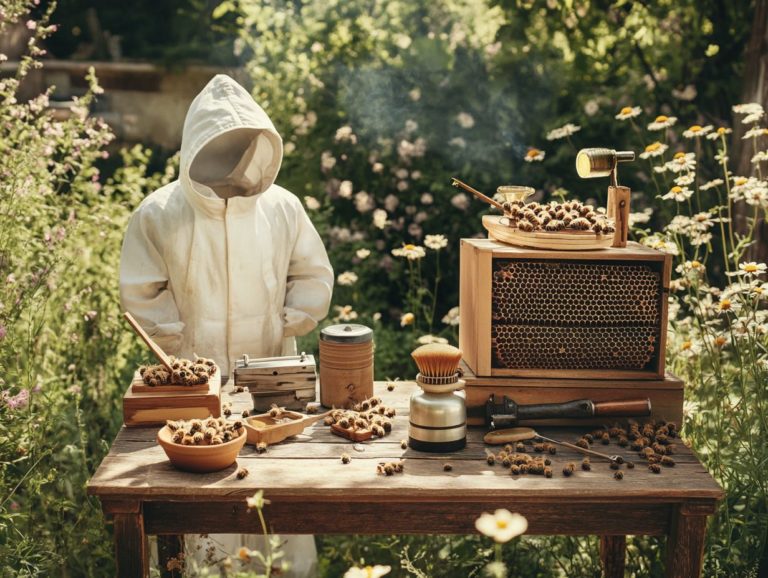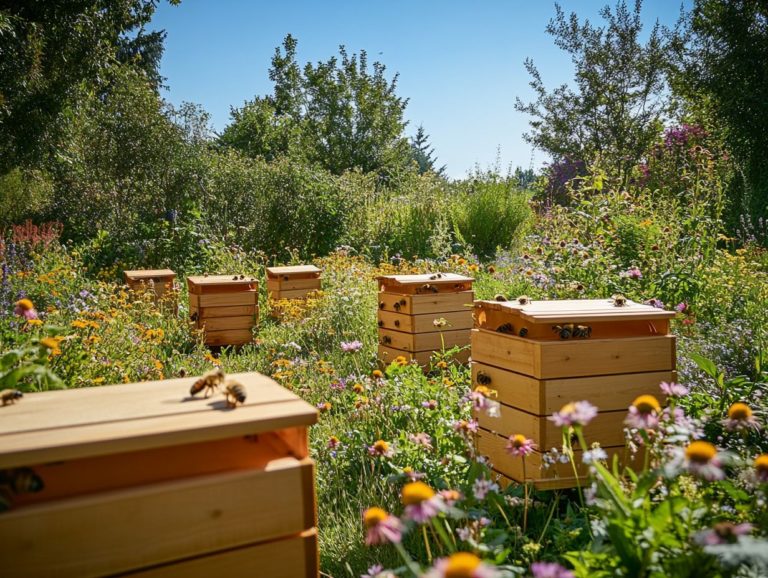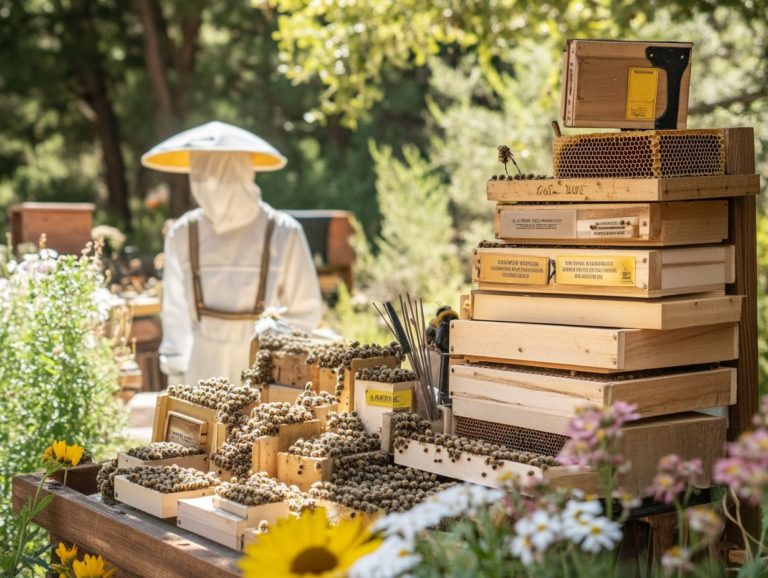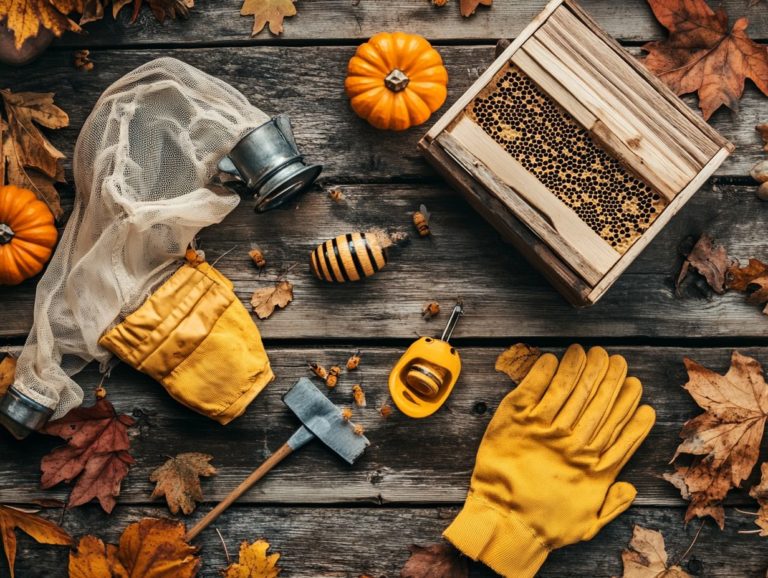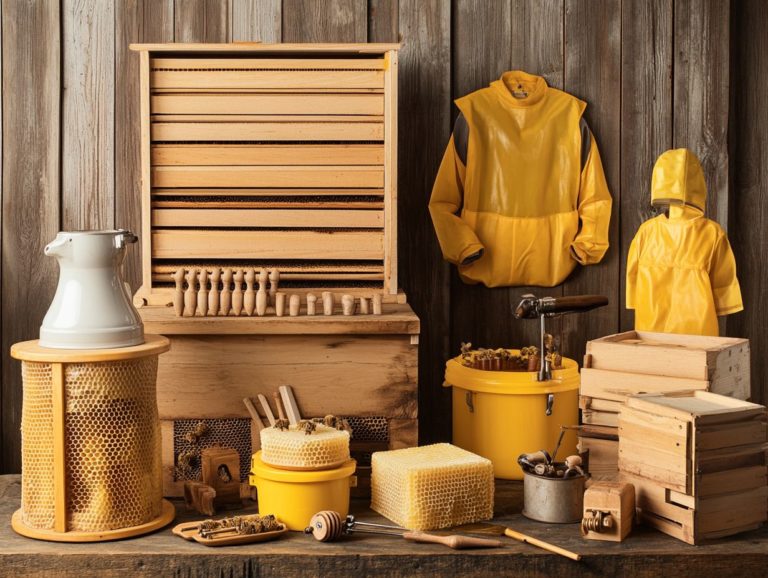Understanding Beekeeping Smokers: A Complete Guide
Beekeeping smokers are indispensable tools for any beekeeper, serving a vital function in managing hives, performing honey extraction, and ensuring the safety of both the bees and those tending to them.
This guide delves into what a beekeeping smoker is, the different types available, and how they operate. It also provides insights on how to use and maintain your smoker effectively, including lighting, cleaning, and key safety precautions to consider.
Whether you re just starting out or you ve been on your beekeeping journey for a while, grasping these essential concepts, including various beekeeping tips and smoking techniques, will significantly enrich your experience.
Contents
- Key Takeaways:
- What Is A Beekeeping Smoker?
- Why Is A Beekeeping Smoker Used?
- How Does A Beekeeping Smoker Work?
- What Are The Types Of Beekeeping Smokers?
- What Materials Are Used To Make A Beekeeping Smoker?
- How To Properly Use A Beekeeping Smoker?
- What Are The Safety Measures When Using A Beekeeping Smoker?
- How to Clean and Maintain Your Beekeeping Smoker
- Frequently Asked Questions
Key Takeaways:
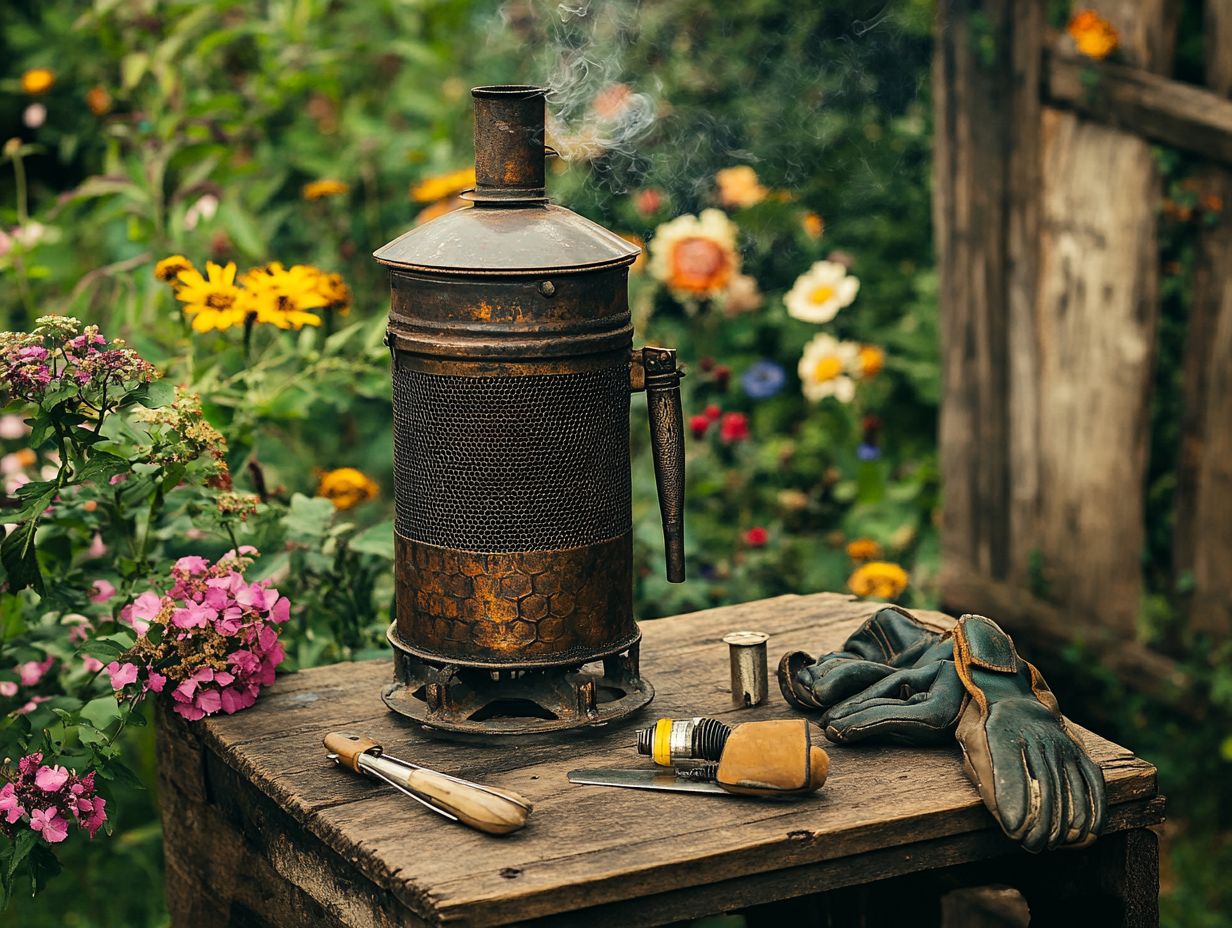
- A beekeeping smoker is a tool used to calm bees during hive inspections, also known as a bee hive smoker.
- The smoke masks the warning signals that cause bees to become agitated and aggressive.
- To use a beekeeping smoker safely, focus on proper preparation, lighting, and maintenance, including understanding bee smoker parts and safety.
What Is A Beekeeping Smoker?
A beekeeping smoker is an essential tool in your beekeeping arsenal, designed to soothe bees during hive inspections and various activities. This technique helps keep the bees calm.
Its primary purpose is to generate smoke that masks the warning signals released by bees, effectively minimizing their aggression and allowing you to work more safely around your colonies.
Typically, a smoker is composed of a fire chamber, bellows, and a nozzle, which enables you to apply smoke in controlled amounts. In some cases, an electric bee smoker can simplify the process.
By grasping the function of a bee smoker, you can elevate your practical beekeeping skills and create a safer working environment around your hives.
Why Is A Beekeeping Smoker Used?
A beekeeping smoker is your essential tool for calming the bees and making hive inspections a breeze by minimizing their aggression, a key beekeeping technique.
When you introduce smoke, it disrupts their natural communication, preventing the release of warning signals that typically indicate danger to the colony. This calming effect allows you to safely inspect the hive, manage the bee colony, and carry out necessary maintenance without setting off their defensive instincts.
Understanding how and why to use a smoker is crucial for your success in beekeeping, ensuring your interactions with honey bees are not just safer but also more effective.
Beyond improving hive management, using a smoker significantly lowers overall stress levels within the colony, demonstrating the effects of smoke on bee behavior.
When you perform routine tasks like checking for diseases or harvesting honey with the aid of smoke, you create a more stable environment for the bees, which promotes healthier colonies. During honey extraction, smoke helps ease the bees’ agitation, leading to a more efficient operation.
Using a smoker boosts your productivity and makes beekeeping more enjoyable! This practice not only nurtures a stronger relationship between you and the bees but also paves the way for a more successful beekeeping venture.
How Does A Beekeeping Smoker Work?
A beekeeping smoker operates by generating smoke that serves multiple purposes, primarily masking the pheromones that bees release during hive disturbances. This method, known as smoke pheromones, helps calm the bees. Understanding what smoke does to bees is crucial for effective beekeeping.
When you light various fuels within the smoker, it produces smoke that, when applied judiciously, can effectively soothe the bees during hive inspections.
How well the smoke works depends on its temperature and the type of fuel used, as different materials yield varying qualities and durations of smoke. Types of fuels beekeepers use include raw wood chips, pine needles, and cardboard.
By understanding how a smoker works, you can apply smoke more effectively and make informed choices about your fuel selection.
For instance, opting for natural materials like wood chips, pine needles, or dried grass can result in cooler, thicker smoke that gradually calms the bees. Beekeepers often prefer these natural materials for their bee smoker fuel.
On the other hand, using synthetic materials can produce a harsher smoke that could irritate both the bees and yourself.
It s essential for you to carefully manage the application of smoke not only for your comfort but also for the health of the hive. Excessive smoke can cause stress or even harm the bees. Hive smoking tips often emphasize using just enough smoke to calm the bees without causing undue stress.
To keep bees calm, gently introduce the smoke, creating a peaceful atmosphere. By applying smoke properly, you ensure that the bees remain undisturbed, allowing you to conduct inspections safely and effectively.
What Are The Types Of Beekeeping Smokers?
You ll find a variety of beekeeping smokers available, each tailored to meet your specific needs and preferences as a beekeeper. Traditional smokers, often crafted from metal with a reliable bellows for airflow, are a favorite for their ease of use and dependability.
If you re looking for enhanced fuel efficiency, top fuel smokers are designed to allow you to utilize a range of materials as fuel. On the other hand, bellow smokers are renowned for their robust airflow, ensuring a steady stream of smoke, which is particularly useful during hive inspections.
Understanding the nuances between these types of smokers is crucial for you to select the right equipment for successful beekeeping.
1. Traditional Smokers
Traditional smokers have been used since the early days of beekeeping. Moses Quinby, a pioneering beekeeper, played a significant role in developing the beekeeping smoker design.
Traditional smokers are the go-to choice for many beekeepers, typically crafted from metal and equipped with a bellows for efficient smoke production. These traditional models are among the most common types of beekeeping smokers.
These tried-and-true devices have stood the test of time, prized for their durability and reliability across various beekeeping tasks.
The construction of these smokers is a testament to precision, often featuring a heat shield to protect against burns and a well-designed chamber that promotes optimal fuel combustion.
The advantages of using a traditional smoker are plentiful. For example, the smoke helps calm the bees, making hive inspections not just safer but also more efficient. You might find beekeepers using an array of fuels, including dried herbs, wood shavings, or even pine needles, each adding its unique aromatic qualities to the experience.
Their enduring popularity is largely due to the serene environment they create for both the beekeeper and the bees. Best practices suggest gradually introducing smoke to prevent overwhelming the colony and ensuring a steady supply of fuel to keep the smoker performing at its best throughout your inspections.
Experiment with various fuels to discover which works best for your hive!
2. Top Fuel Smokers
Top fuel smokers are crafted with exceptional fuel efficiency in mind, allowing you to use a variety of materials to produce smoke. These smokers are highly valued in practical beekeeping for their efficiency and reliability. This versatility is one of the key advantages of this type of beekeeping equipment.
These smokers often include advanced features that optimize airflow and combustion, making them the preferred choice for those who enjoy longer smoking sessions.
With their robust construction and carefully made components, these smokers ensure a consistent burn and significantly extend the duration of effective smoke release. You ll appreciate how many top fuel smokers incorporate adjustable vents, enabling you to control both the intensity and volume of the smoke produced an essential feature for calming bees during hive inspections.
Whether you prefer wood chips, burlap, or even pine needles, these smokers work remarkably well with various fuels, allowing you to choose based on what s available and the specific smoke characteristics you desire. To get the most out of your fuel smoker, remember to pack the fuel loosely. This promotes airflow and ensures an even ignition, resulting in a reliable source of smoke throughout your entire beekeeping process.
3. Bellow Smokers
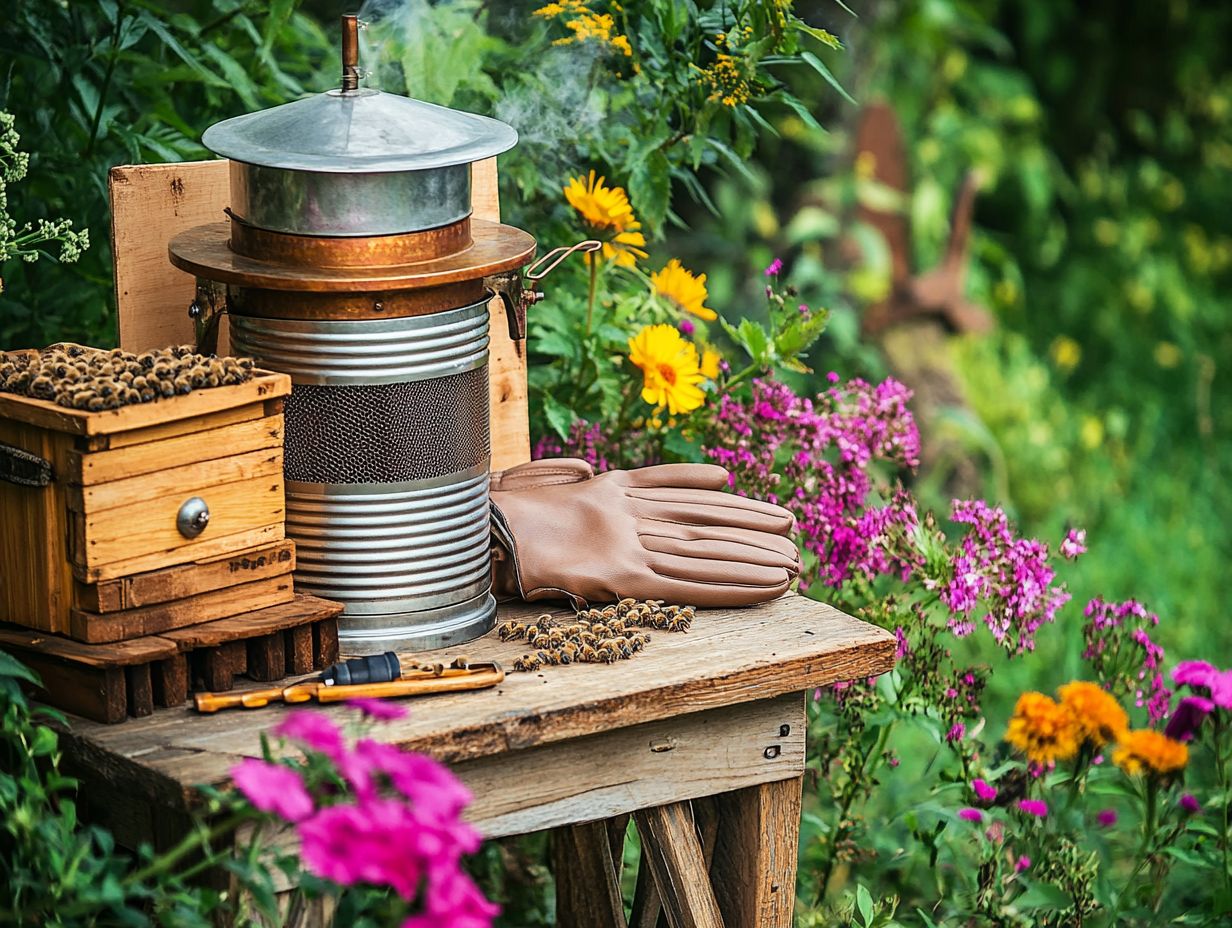
Bellow smokers are essential tools for every beekeeper! They are renowned for their robust airflow mechanisms that deliver a consistent and powerful stream of smoke essential for effective hive inspections.
With these smokers in hand, you can apply smoke more efficiently, ensuring that your bees remain calm and cooperative during their examinations. Beyond creating a serene atmosphere, bellow smokers excel in enhancing smoke distribution throughout the hive, reaching deep into the nooks and crannies where bees tend to cluster. This helps calm aggressive bees and stops them from swarming.
For optimal results, it s best to light your smoker with natural materials, ensuring it produces cool smoke instead of hot flames. Regularly pumping the bellow guarantees a steady flow, which is vital when you re opening hives for inspections or harvesting honey. By mastering these tools, you ensure not only your safety but also promote thriving bee colonies!
What Materials Are Used To Make A Beekeeping Smoker?
Beekeeping smokers are crafted from a variety of materials, with metal taking center stage for its durability. The importance of sturdy and reliable beekeeping equipment cannot be overstated. Components of the bee smoker, like the bellows and fuel chamber, are essential for its effective operation. Heat-resistant materials are crucial for the smoker’s performance and longevity, as they help it endure heat and deliver effective smoke.
You ll find a range of fuel options available, from natural materials like raw wood chips and cardboard to synthetic alternatives. Each type of fuel influences the smoke quality and the bees’ responses. Hive tools, bee vacuums, and other beekeeping accessories often complement the use of a smoker in maintaining a healthy bee colony. Understanding the types of fuels used in beekeeping is key to effective hive management.
Metal smokers are particularly renowned for their excellent heat retention, which is vital for consistent smoke production. Fire safety is paramount when using any type of smoker, so ensure the smoker is extinguished properly after use to prevent accidental fires.
Proper maintenance, such as regular cleaning and checking for wear, ensures your equipment remains in good working order. For example, stainless steel is a popular choice due to its resistance to rust and corrosion. Alternatively, you might prefer copper for its aesthetic charm and exceptional thermal conductivity, allowing for a steady burn. The bellows, typically crafted from wood and durable fabric, play a crucial role in generating airflow to sustain the smoke.
To ensure optimal performance, routine maintenance and regular checking of your bee smoker parts are essential. Regular cleaning prevents residue buildup, which can affect smoke quality and compromise efficiency. In terms of your choice of fuel, using bee smoker fuel such as raw wood chips produces a thick, pungent smoke that effectively calms the bees, while cardboard generates a lighter, cooler smoke better suited for certain situations.
Selecting the right fuel not only impacts the smoke s effectiveness but also significantly contributes to the overall health and behavior of your bee colony.
How To Properly Use A Beekeeping Smoker?
Follow these essential steps to ensure a safe and effective beekeeping experience! To properly utilize a beekeeping smoker, you must prioritize both the safety of the bees and understand what smoke does to them.
Start by mastering the art of lighting the smoker correctly. Ensure a consistent flow of smoke as you work. The right technique soothes the bees and keeps them calm, making your inspections and interactions with the hive much smoother. Using the right hive tools enhances your overall beekeeping experience.
1. Prepare The Smoker
Preparing your smoker requires a meticulous approach. Ensure it is clean, well-maintained, and filled with the right fuel to generate effective smoke. Before lighting it up, inspect all the smoker parts for any signs of wear or damage. Choosing the right materials, like raw wood chips, cardboard, burlap, or pine needles, will significantly enhance smoke production.
A thorough inspection is essential; even minor damages to your bee hive smoker can undermine efficiency and safety. Selecting the appropriate fuel based on the day s conditions can impact the quality and duration of the smoke. For instance, dry materials are ideal for humid weather, while heavier fuels like wooden shavings may be better suited for windy conditions.
Regular cleaning of your smoker with soft brushes is crucial to prevent buildup, which can lead to subpar smoke quality. By following these maintenance tips, you can ensure reliable performance for your beekeeping activities, allowing you to focus on your beekeeping tasks with confidence.
2. Light The Smoker
Lighting the smoker is an important step in smoke application that demands your careful attention to fire safety and technique to ensure a steady stream of smoke. Start by placing dry fuel in the fire chamber; then ignite it safely and use the smoker bellows the device used to blow air into the smoker to help the fire to fan the flames until you achieve a consistent output of smoke.
To kick off the process, choose the right type of fuel options like pine needles, burlap, or wooden shavings are excellent for producing dense smoke. Once you ve arranged the dry material in the fire chamber, strike a match or use a lighter with care, keeping your hands clear of the flame and the smoker open to allow for proper airflow and smoke output.
After the initial flame ignites, gently pump the bellows to circulate air, encouraging the smoldering fuel and smoker temperature and smoke effects to generate a steady and plentiful output. This method effectively calms the bees and creates a safe working environment, significantly reducing the risk of accidental fires.
3. Keep The Smoker Going
To keep your smoker running smoothly, it’s essential to regularly monitor fuel levels and smoker maintenance. You must maintain a controlled temperature, ensuring a steady supply of smoke during your hive inspections.
Add fresh fuel as needed and apply the smoke thoughtfully to keep your bees calm and minimize any unnecessary stress throughout the inspection process. Effective fuel management is key; opt for dry leaves, pine needles, burlap, or other natural materials to create the right amount of smoke without overwhelming the hive.
Timing is critical apply smoke just before opening the hive and during any disturbances to help soothe the bees. Once your inspection wraps up, make sure to extinguish the smoker safely. Tap the fire chamber against a flat surface and close the air vents to cut off the oxygen supply. This keeps things safe and allows you to reuse that fuel in your future inspections.
What Are The Safety Measures When Using A Beekeeping Smoker?
When using a beekeeping smoker, prioritizing safety measures is essential for the well-being of both you and your bees. Begin with the right protective gear a sturdy bee suit and gloves are vital to shield yourself from potential stings.
Equally important is adhering to fire safety protocols while handling the smoker, particularly when using flammable materials and comb as fuel. By constantly overseeing the smoker while smoking the bees and implementing preventive measures, you can create a safer environment to effectively manage your hives and enjoy the rewarding experience of beekeeping.
1. Wear Protective Gear
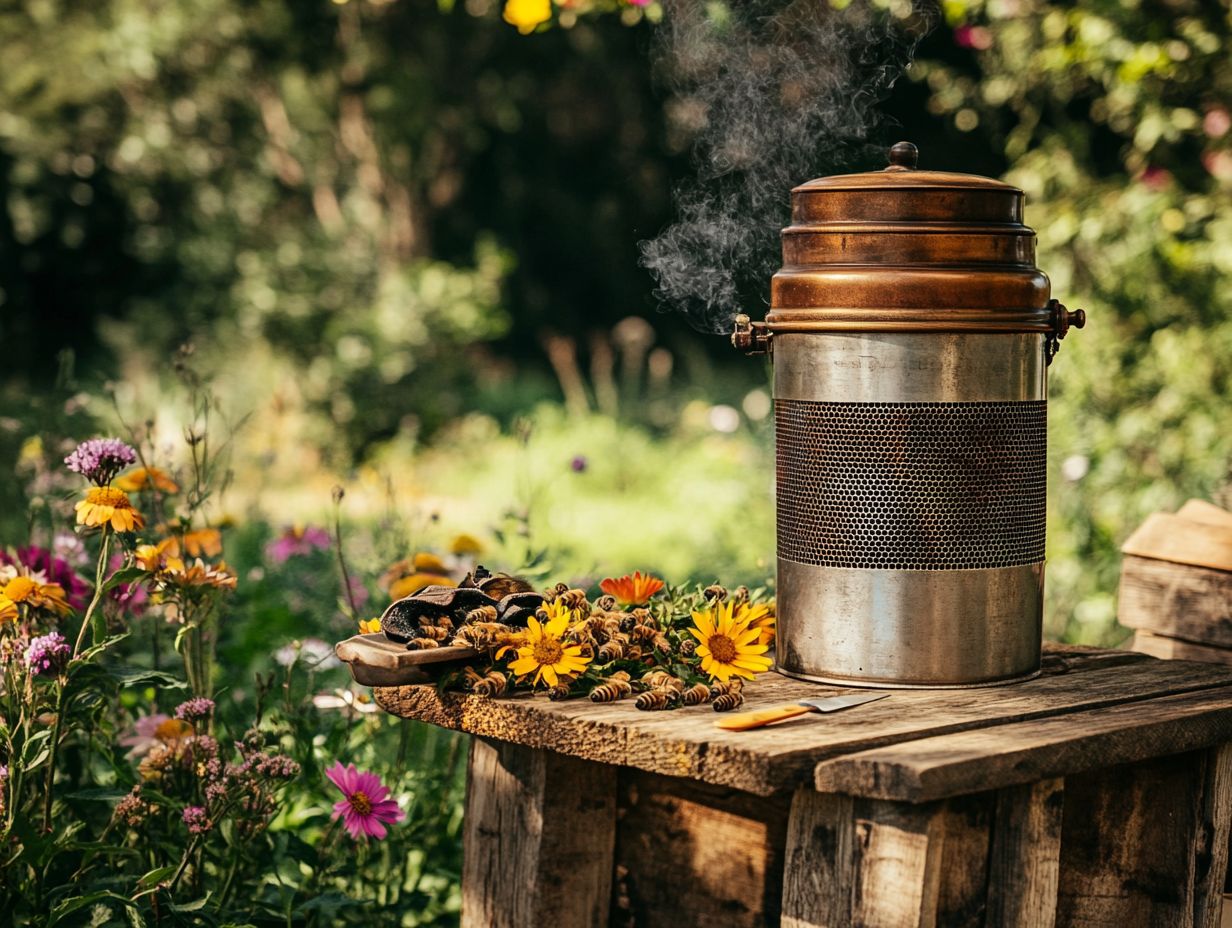
Wearing protective gear is absolutely essential for you as a beekeeper when using a smoker. It minimizes the risk of bee stings and enhances your overall safety during hive inspections.
A proper bee suit, paired with gloves and a veil, creates a protective barrier that allows you to work with confidence, focusing on managing your hives without the looming fear of aggressive bee behavior.
Beyond the basics, consider adding extra layers of protection like knee pads, especially useful for maintenance tasks that require some serious kneeling. High-quality gloves are a game-changer, providing a secure grip while keeping your hands safe the most vulnerable area during an inspection.
This gear is crucial for your safety and comfort. By alleviating physical discomfort and anxiety tied to potential bee stings, you’re more likely to engage in the necessary hive management practices.
This ultimately leads to healthier colonies and improved yields, making your beekeeping experience all the more rewarding.
2. Keep Children and Pets Away
It is essential for you as a beekeeper to keep children and pets away from the area where a beekeeping smoker is in use to ensure their safety and prevent accidents. The smoke can pique the curiosity of both, leading to potential harm from bee aggression or unintended contact with the smoker, which can be hot and dangerous.
Establishing a designated safe zone around your beekeeping area is crucial for anyone involved in taking care of your bee farm. By setting up physical barriers or placing clear signs, you can effectively communicate to children and pets that they need to keep their distance.
During hive inspections, engage children in safe and distracting activities, like bee attraction activities, while ensuring that pets are secured indoors or in a separate location away from the beekeeping site.
Implement fire safety practices! Have a fire extinguisher or water spray readily available and ensure the smoker or electric bee smoker is placed on a non-flammable surface or using sand. This can significantly enhance safety for everyone involved.
3. Monitor the Smoker at All Times
Always monitor your smoker during use for fire safety. Regularly check fuel levels, temperature, and smoke output.
Position your smoker on a stable, non-flammable surface to further reduce fire risks. Using dry materials like wood shavings or paper can enhance smoke output, but it’s vital to keep the temperature manageable.
Once you’re done, allow the smoker to cool down in a well-ventilated area that’s clear of flammable materials before extinguishing it. A simple water spray or some sand will safely eliminate any remaining embers before honey extraction, ensuring that no ash or sparks endanger your surroundings or your beekeeping site.
How to Clean and Maintain Your Beekeeping Smoker
Utilizing hive smoking tips, ensure your smoker remains efficient. Cleaning and maintaining your beekeeping smoker is crucial for ensuring its longevity and optimal performance of your beekeeping equipment. Understanding that smoke can harm bees throughout the beekeeping season is essential.
Proper maintenance entails regular inspection and cleaning of the smoker s components, including the fire chamber and bellows, to prevent blockages and guarantee efficient smoke production.
By adopting consistent maintenance practices, you can significantly enhance your overall experience when managing your hives. A well-maintained smoker operates more effectively and contributes to a safer beekeeping environment.
1. Cleaning After Use
Cleaning your smoker after each use is absolutely essential for maintaining its functionality. Prevent residue buildup that could hinder its performance. Once the smoker has cooled down, carefully remove any remaining fuel and honey bee residue from the fire chamber. Ensure all parts of the smoker are free from blockages and ready for your next session.
This diligent practice guarantees a smoother operation and extends the lifespan of your smoker. Transform it into a reliable tool for effectively managing your hives. Utilize soft brushes or cloths to help dislodge stubborn particles. Be cautious to avoid abrasive materials that could harm the smoker’s surface.
By keeping your smoker clean, you’re fostering a safer environment for your bees. Minimize the risk of imparting any unpleasant flavors from burnt fuel. Ultimately, a well-maintained smoker becomes an essential ally in your beekeeping journey, ensuring both efficiency and the health of your hive. Regular cleaning is one of the most important beekeeping tips for maintaining a healthy hive.
2. Regular Maintenance
Regular maintenance of your smoker is essential for ensuring its reliability and consistent performance during hive inspections and other beekeeping activities.
This means routinely inspecting for wear and tear on smoker parts, such as the bellows, and making sure the fire chamber is clear to allow optimal airflow and smoke production. Knowing how to use and maintain your smoker is crucial for practical beekeeping.
Check the nozzle s condition frequently; any clogs can lead to inefficient smoke delivery, which is crucial for keeping bees calm during inspections. Cleaning away any residue and checking for proper seals are vital tasks that can prevent smoke leaks and ensure a steady flow.
It s wise to keep a well-stocked supply of smoker fuel like untreated wood chips or pine needles on hand to avoid any interruptions during your hive visits. Other commonly used bee smoker fuel includes dried pine needles or raw wood chips.
By regularly inspecting the entire smoker system, you not only maintain its functionality but also enhance the overall efficiency of your beekeeping practices.
3. Replacing Parts
Replacing worn or damaged parts of your bee smoker is essential for maintaining its efficiency and safety during your beekeeping activities.
Key components that often need replacement include the bellows, fire chamber liners, and any other parts that show signs of wear after regular use. Regularly checking your smoker bellows ensures bee smoker safety and efficiency.
To determine when these parts should be replaced, inspect your smoker routinely for visible wear or any not working well. Keep an eye out for diminished airflow from the bellows or excessive rust in the fire chamber these are clear indicators that it s time for a change. This will help avoid issues during beehive inspection.
Sourcing new components is usually straightforward, whether through local beekeeping supply stores or reputable online retailers that provide a range of aftermarket and OEM parts. Understanding the different bee smoker parts can help in finding the right replacements.
By regularly replacing these worn components, you not only enhance the performance of your smoker but also ensure it operates reliably, making it an effective tool for safely managing your hives over time. This consistent maintenance contributes to hive inspection and other hive smoking tips.
Frequently Asked Questions
In this section, we answer common questions about beekeeping smokers, their importance, and how to choose the right one.
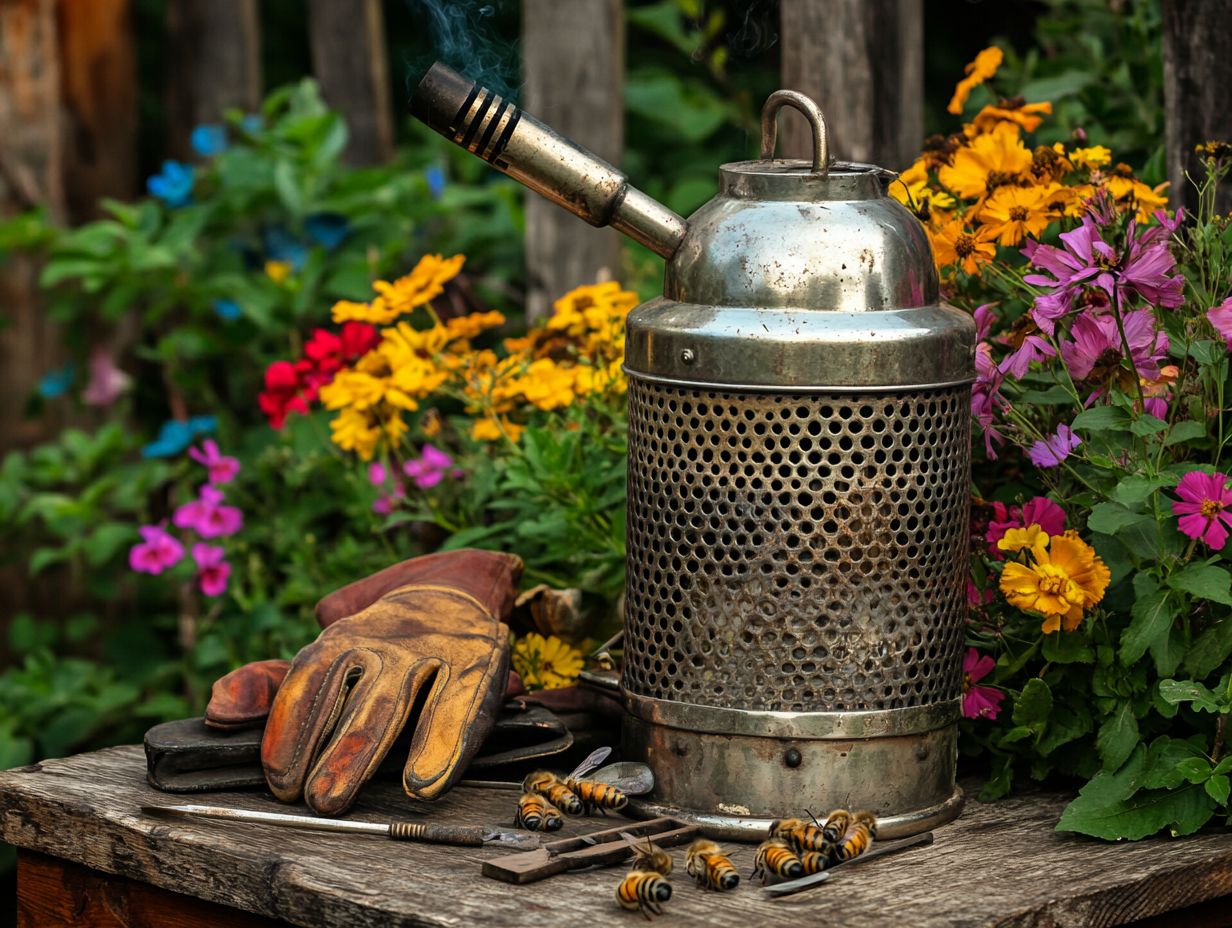
What is a beekeeping smoker and why is it important?
A beekeeping smoker is a tool used by beekeepers to calm bees during hive inspections. It is important because it helps prevent bee stings and allows for easier and safer management of the hive. This method, known as smoking bees, is a staple in practical beekeeping.
How does a beekeeping smoker work?
A beekeeping smoker works by producing smoke, which interferes with the bees’ communication and triggers a feeding response. This makes the bees less aggressive and easier to handle. Understanding what smoke does to bees is crucial for effective beekeeping.
What are the different types of beekeeping smokers?
There are several types of beekeeping smokers, including traditional bellows smokers, pump smokers, and electric smokers. Each type has its own advantages and disadvantages, so it’s best to choose one that suits your needs and preferences. For instance, an electric bee smoker offers convenience but may be more expensive.
Experimenting with different smoking techniques can also help you find the best method for your hive.
Now that you understand the importance of maintaining your smoker, keep it in top shape to ensure successful hive inspections!
How do I use a beekeeping smoker?
Start by lighting a small amount of fuel, like pine needles or cardboard, in the smoker’s firebox. Once it is lit, pump the bellows to create smoke. Direct the smoke towards the hive entrance and frames. Proper smoke application is key to calming the bees during hive inspections.
What type of fuel should I use in my beekeeping smoker?
The best fuels for beekeeping smokers are dried pine needles or pine shavings. Other options include burlap, cardboard, or cotton rags. Choose a fuel that produces cool, white smoke to keep the bees safe.
How often should I clean my beekeeping smoker?
You need to clean your beekeeping smoker regularly. This prevents harmful residue buildup that can create irritating smoke. Clean it after each use by removing leftover fuel and wiping the inside with a cloth or paper towel.

